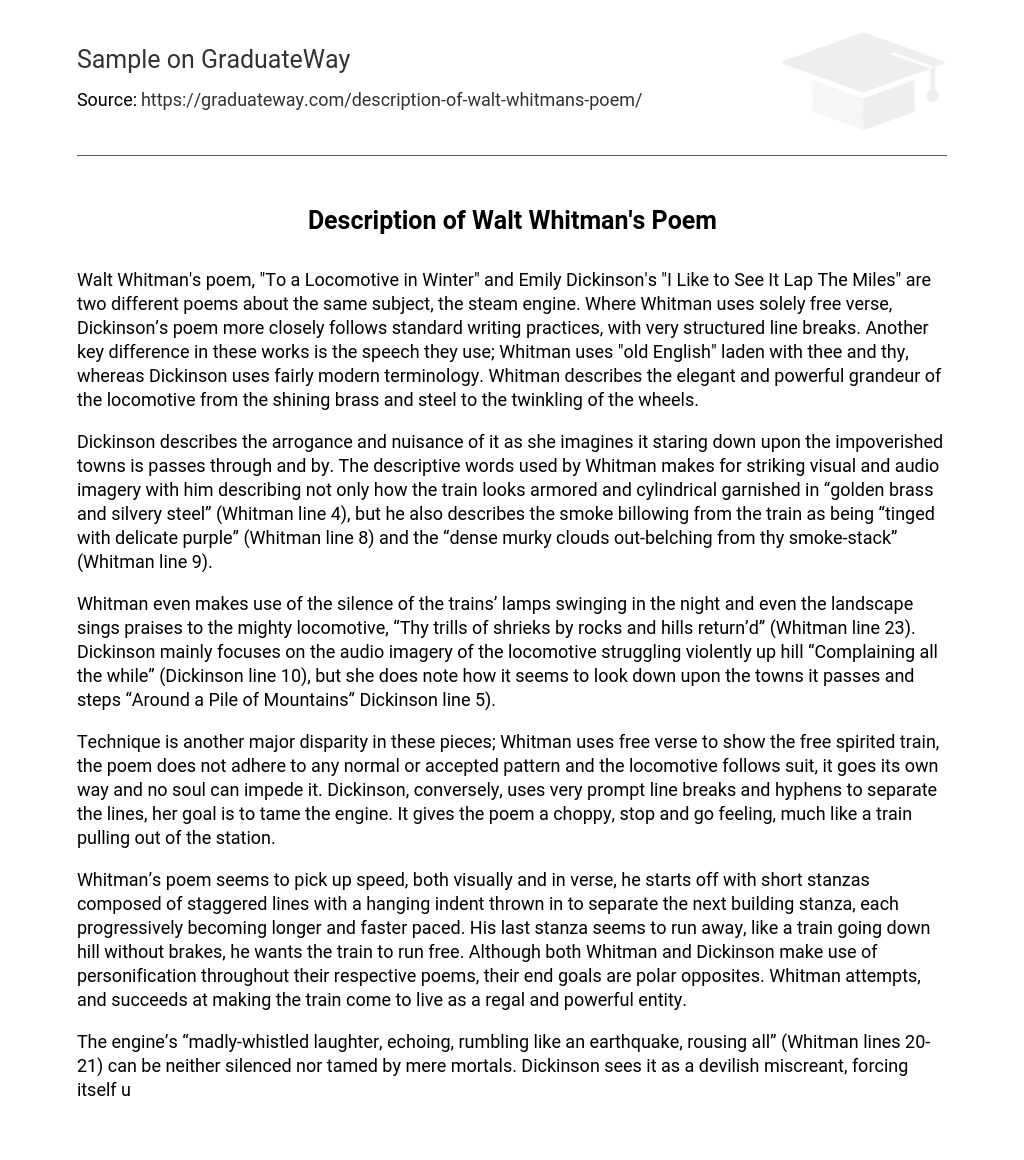Both Walt Whitman and Emily Dickinson wrote poems about the steam engine, specifically “To a Locomotive in Winter” by Whitman and “I Like to See It Lap The Miles” by Dickinson. Whitman’s poem is written in free verse while Dickinson’s poem has more structured line breaks. In terms of language, Whitman uses “old English” with words like thee and thy, while Dickinson’s language is more modern. Whitman focuses on the beauty and power of the locomotive, describing its shining brass and steel as well as the sparkling of its wheels.
Dickinson portrays the train as an arrogant and annoying presence that gazes down on the impoverished towns it travels through. Whitman’s use of descriptive language creates vivid visual and auditory imagery. He portrays the train as armored and cylindrical, adorned with “golden brass and silvery steel” (Whitman line 4). Additionally, Whitman describes the smoke emanating from the train as tinged with a delicate purple hue (Whitman line 8), and the dense, murky clouds belching from its smokestack (Whitman line 9).
Whitman utilizes the quietness of the trains’ lamps swaying in the night and the scenery itself sings praises to the powerful locomotive, with “Thy trills of shrieks by rocks and hills return’d” (Whitman line 23). On the other hand, Dickinson primarily concentrates on the auditory imagery of the locomotive laboriously ascending a hill “Complaining all the while” (Dickinson line 10), but she does acknowledge how it appears to gaze upon the towns it traverses and steps “Around a Pile of Mountains” (Dickinson line 5).
Both Whitman and Dickinson employ different techniques to convey their ideas about trains. Whitman uses free verse, where the poem lacks a specific pattern or structure, mirroring the free-spirited nature of the train. The locomotive goes its own way without any hindrance. In contrast, Dickinson uses swift line breaks and hyphens to create separation between lines, aiming to control the engine. This technique gives the poem a choppy, start-and-stop sensation, similar to a train departing from a station.
Whitman’s poem appears to gain momentum, both visually and in verse. He begins with concise stanzas made up of staggered lines that are separated by a hanging indent. As the poem progresses, each stanza becomes longer and faster-paced. The final stanza seems to sprint away like a brakeless train going downhill; Whitman desires the train to run free. While both Whitman and Dickinson utilize personification in their poems, their ultimate objectives are completely contrasting. Whitman endeavors, and triumphs, in endowing the train with a majestic and potent essence.
The train’s laughter, described by Whitman as “madly-whistled laughter, echoing, rumbling like an earthquake, rousing all” (Whitman lines 20-21), is unstoppable and untamable by humans. Dickinson views it as a devilish troublemaker, imposing itself on both the land and people, bypassing mountains, slicing through quarries, and looking down on humanity. Without regard for its surroundings, she compares the train’s noise to the loud cries of Boanerges. Similar to the biblical disciples John and James, she perceives the locomotive as loud and rowdy.
Both poets express their admiration for the locomotive, but while Whitman has a deep love for the machine, calling it a “Fierce-throated beauty” (Whitman line 18) and an “emblem of motion and power” (Whitman line 12), Dickinson simply appreciates it as she observes it “stop to feed itself at the Tanks” (Dickinson line 3) and notices the “Shanties-by the sides of the roads” (Dickinson line 7). Whitman writes an ode to the locomotive, urging it to “serve the Muse and merge in verse” (Whitman line 14), desiring it to work for him and become part of his poetry.
The author perceives the locomotive to have a sense of superiority over the humans, structures, and landscape it encounters, but this changes when it struggles to climb a hill and complains throughout the process (Dickinson line 11). Despite its clumsiness, Whitman’s poem is lively and enjoyable to read, although it may require a dictionary nearby. He vividly portrays the steam-driven locomotive on the page with descriptions of its heavy side-bars, parallel and connecting rods, and gyrations (Whitman line 5), allowing the reader to witness the metal’s violent swinging motion.
When describing the smoke rising from the machine, one can almost feel the oily vapors on their face and nostrils. The ringing bell in the distance adds to the experience, and at the end, as the machine launches across the praries and lakes into the free skies, the reader can catch a glimpse of the ghost train gliding into the sunset.
Works Cited: Whitman, Walt. “To a Locomotive in Winter. ” Literature; An Introduction to
“In Fiction, Poetry, Drama, and Writing. 6th Ed., X. J. Kennedy and Dana Gioia discuss the work of Emily Dickinson in their book published in Boston by Longman in 2010 (p. 426). In particular, they mention her poem ‘I like to see it lap the Miles,’ which can be found on page 427 of the same book. I found your analysis of these two poems and their portrayal of steam-engine trains quite interesting. One observation that stood out to me was your remark on Whitman’s successful attempt to bring the train to life, depicting it as a majestic and formidable presence.”
According to Whitman, the engine’s laughter is wild and echoing, resembling an earthquake, and it cannot be suppressed or controlled by humans. On the other hand, Dickinson views the train as a devilish troublemaker that disregards its surroundings, traversing mountains and quarries and looking down on humanity. She compares its loud voice to the cry of Boanerges. In my opinion, this paper effectively explores two contrasting views of steam-engine trains. It would be beneficial to incorporate more of this analysis. Overall, well done.





